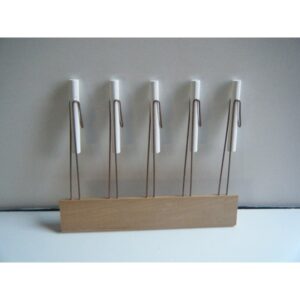When you choose to live in an uber tiny space, you have to carefully curate the stuff you live with. For no reason I can explain, this vintage blackboard is a keeper. I even love the additions of the hanger and attached chalk someone made along the way.

Before the invention of the blackboard, students did have access to individual slates. This helped cut down on the cost and need of the sometimes unavailable paper and pencil supplies – just a wood board painted over with black grit. Credit for the invention of the blackboard? James Pillans, Headmaster of the Old High School in Edinburgh, Scotland. By 1801, George Baron, an instructor at West Point Military Academy added a large black chalkboard into to his math presentation as the first American Instructor to use a blackboard. As the railroad industry expanded, large pieces of slate were becoming more accessible and affordable to more schools. School houses across America rapidly adopted the chalkboard as it allowed them to educate larger numbers of children and saved teachers from the arduous task of re-writing problems on individual slates. By the mid-1800’s, chalkboards were found in almost every school house and became one of the most important educational tools in early American history.


By the 1960’s the blackboard was green and portable. The handy device on the left could add straight lines to a chalkboard lesson! By the 1990’s the whiteboard using erasbale markers was more common in schools and in the work environment. In 2020 the “board” is glass and in some instances even interactive.
Chalkboard vs. Whiteboard, you choose.
- Chalk requires no special care; whiteboard markers must be capped or else they will dry out.
- Chalk is cheaper than whiteboard markers for a comparable amount of writing.
- It is easier to draw lines of different weights and thicknesses with chalk than with whiteboard markers.
- Chalk has a mild smell, whereas whiteboard markers often have a pungent odor.
- Chalk writing often provides better contrast than whiteboard markers.
- Chalk can be easily erased; writing which has been left on a whiteboard for a prolonged period may require a solvent to remove.
- Chalk can be easily removed from most clothing; whiteboard markers often permanently stain fabric, wood (wood frame), etc.
- Chalk is mostly biodegradable, whereas most plastic recyclers will not take whiteboard markers.